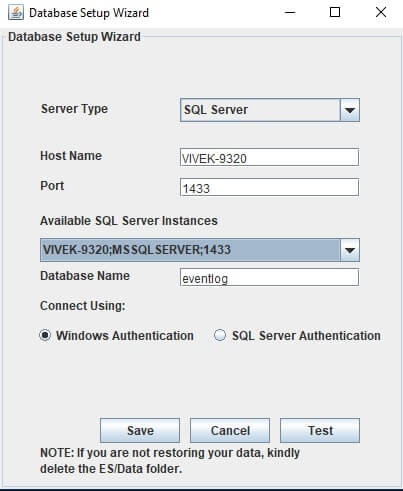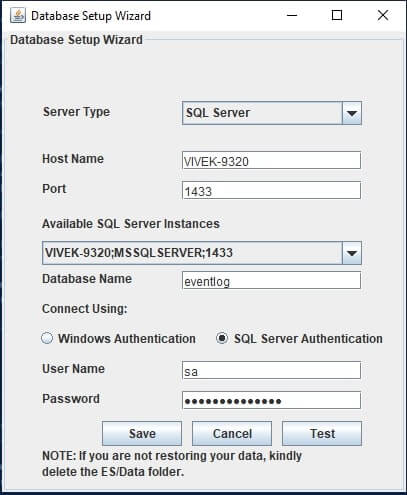Configure MSSQL database
How to find build number?
In the EventLog Analyzer web client, and click Help > About link in the top pane. You will find the build number mentioned below the build version. This is the build number of the currently installed EventLog Analyzer.
Procedure for EventLog Analyzer version 8.0 (Build 8010) onwards
EventLog Analyzer lets users to configure and use MSSQL database.
The procedure to configure the MSSQL is applicable only for fresh installation of EventLog Analyzer server.
The steps to configure and run the Eventlog Analyzer server with SQLSERVER as the database is given below:
- From the installed MS SQLSERVER, copy the files bcp.exe and bcp.rll to <Eventlog Analyzer Home>bin folder.
-
Invoke the <Eventlog Analyzer Home>toolschangeDBServer.bat, to configure the MS SQLSERVER credentials like ServerName, Port, UserName and Password.
-
Database Setup Wizard pops-up.
-
In the wizard screen, select Server Type as SQL Server. Available SQL Server Instances are listed in a combo box. Enter the Host Name and Port of the SQL Server from the instances.
-
Select the authentication type using the "Connect Using:" options.
-
The options are:
For Windows Authentication, enter the Domain Name, User Name and Password. Ensure that both EventLog Analyzer server and SQL Server are in the same domain and logged in with the same Domain Administrator account.

For SQL Server Authentication, enter the User Name and Password.

- SQL Server Authentication
For Windows authentication or SQL server authentication, Server Role of the user should be 'sysadmin' and Database Role of the user should be 'db_owner'.
The members of sysadmin server role can perform any activity in SQL Server and have completes control over all database functions.
The members of db_owner database role can perform any activity in the database.
-
Click Test button to check whether the credentials are correct. If the test fails, the credentials may be wrong, recheck and enter the correct credentials.
-
Clcik Save button to save the SQL Server configuration. Note that, it will take few minutes to configure the settings of the SQL Server database.
-
Start the Eventlog Analyzer Server/Service to work with the MS SQLSERVER as the database.
From the installed MS SQLSERVER, copy the files bcp.exe and bcp.rll to <Eventlog Analyzer Home>bin folder.
Procedure for EventLog Analyzer version 8.0 (Build 8000) or earlier
The procedure to configure the MSSQL is applicable only for fresh installation of EventLog Analyzer server.
From the installed MS SQLSERVER, copy the files bcp.exe and bcp.rll to <EventLog Analyzer Home>mysqlbin folder and follow the procedure given above.
If you are already using the EventLog Analyzer with MySQL and you want to change the database to MSSQL, please refer the Migrating EventLog Analyzer Data from MySQL to MSSQL Database page and follow the procedure given there.













